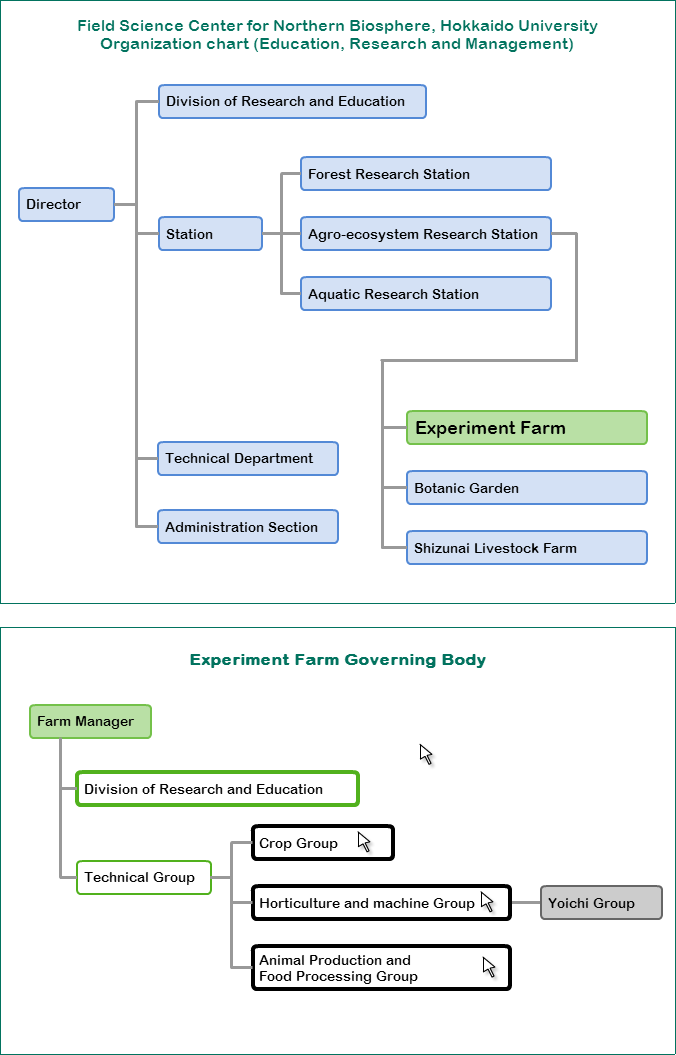Greetings from The Hokkaido University Farm Manager
Established at the same time as the opening of Sapporo Agricultural College
A pioneering role in the development of the Hokkaido agriculture
Our Experiment Farm, The Hokkaido University Farm, is located within the university campus.
It consists of The First Farm (35ha) located on the west side of Poplar Avenue, The Second Farm (23ha) located on the north of Kita 18-jo and Yoichi Orchard (6ha) in Yamadacho, Yoichi Town. The Farm was established at the same time as the opening of Sapporo Agricultural College in 1876 (Meiji 9), using the experiment farm in The Massachusetts Agricultural College as a model. As a model farm for large-sized agriculture, the Farm has played a pioneering role in the development of the Hokkaido agriculture, conquering the severe environmental conditions in the northern areas, such as the low temperatures in the summer, heavy snow, very low temperatures of the winter. Also many talented people have been trained here.
Cutting-edge researches in prospective of both “Productivity” and “Sustainability”
Hokkaido serves as a food base in Japan today, though from now on, agricultural output which harmonizes with the environment is called for even amidst international competition. On the other hand, the use of biomass and natural energy etc. also attract attention for the construction of a low carbon society.
In such a background, cutting-edge researches on agriculture and energy are carried out at The Hokkaido University Farm: Crop cultivation and livestock husbandry utilizing the characteristic climatic conditions of Hokkaido, the environmental improvement of agricultural field, grassland and institutions as well as genetic improvement of the bioresources in snowy-cold regions are undertaken. We conduct a total system of production and processing of agricultural and livestock products. Further we carry out researches on renewable energy, bio-refinery materials production in farmland, such as biomass crops, biogas, and pellets, etc.
The faculty members strive to contribute to the training of talented people with an awareness of the issues and problem-solving capability both from the perspective of “Sustainability”; the sustainable use of ecosystem services, in addition to the improvement in the “Productivity” as in conventional agriculture.
The Hokkaido University Farm Manager
History
1876, upon the opening of Sapporo Agricultural College, under the guidance of Dr. W.S. Clark of Massachusetts Agricultural College was invited as a director, trial field and our farm were established as a model farm. Until the Furano Eighth Farm from the First and Second Farms in Sapporo city, farms had expanded the scale to more than 6,000 ha indeed, including Yoichi Orchard. Most of them were peasant field. It has a “pioneer spirit”, was changed to arable land by clearing the virgin forest, and laid the foundation of agriculture in Hokkaido. Because it was used in a new building sites, such as the university and the release of agricultural field to the peasant after the war, now is the management of 60 ha in Sapporo campus and Yoichi Orchard 5 ha. In 2001, the integration among affiliated education and research facilities of the Faculty of Agriculture, Faculty of Fisheries and Faculty of Science as the Field Science Center for Northern Biosphere assigned the Experiment Farm to be one of facilities in Agro-ecosystem Research Station. Recycling system using the biogas plant with relocating the pig and poultry house and barn for cattle was completed in 2005. Agri-Food Center (food processing) was established in 2011. Administration building of Field Science Center including Farm Office was renovated in 2009.In response to jurisdiction conversion of 100ha to the northwest end of Sapporo, was installed Nogakuen (Dr. W. S.Clark, Director) at the same time as the opening of the Sapporo Agricultural College.
1895Sapporo Agricultural College changed to be under the direct control of the Ministry of Education.
Tohoku Imperial University era (1907 – 1917)
Hokkaido Imperial University era (1918 – 1946)
Hokkaido University era (1947 – current)
2001
It was reorganized into Experiment Farm, Agro-ecosystem Research Station in the Field Science Center for Northern Biosphere, which was established by the integration of a joint-use facility in campus and nine facilities which belonged to Faculty of Agriculture, Faculty of Science, and Faculty of Fisheries.
Outline of the Facility
Our activity to support field research
The Experiment Farm belongs to, Field Science Center for Northern Biosphere, Hokkaido University. The Experiment Farm in Sapporo occupies 58 ha arable field where is located in two places in Sapporo campus (First Farm / about 35 ha, and Second Farm / about 23 ha). Yoichi Orchard, the branch of the Experiment Farm, is located in the Yoichi town, where is a distance of about 60km from Sapporo. The cultivated acreage of the Yoichi Orchard is a 5.7 ha. Our Organization is composed of five faculty members (two professors, one associate professor, and two assistant professors) and technical staff of 22 persons. The location at the main campus allows the Experiment Farm to be an advantage in to promote interdisciplinary research with every faculty in Hokkaido University. Especially, the Experiment Farm can support education and research in Faculty of Agriculture (School of Agriculture / Graduate School of Agriculture / Research Faculty of Agriculture). For graduate education, faculty members belong to the course in Agro-ecosystem Science, Division of Biosphere Science, the Graduate School of Environmental Sciences. We are conducting educational research by evaluating and improving biological resources, and developing management techniques for sustainable agricultural production, and contributing energy production in agriculture sector.Farm equipment
- Building
- Garage
- Hangar
- Dairy production research facility (barn, metabolism measurement chamber, bio-gas plant, etc.)
- Pig and poultry production research facility (piggery, poultry house)
- Agri-Food Center (processing facilities of agricultural products and livestock products)
- Horticultural facility
- Sericulture room


